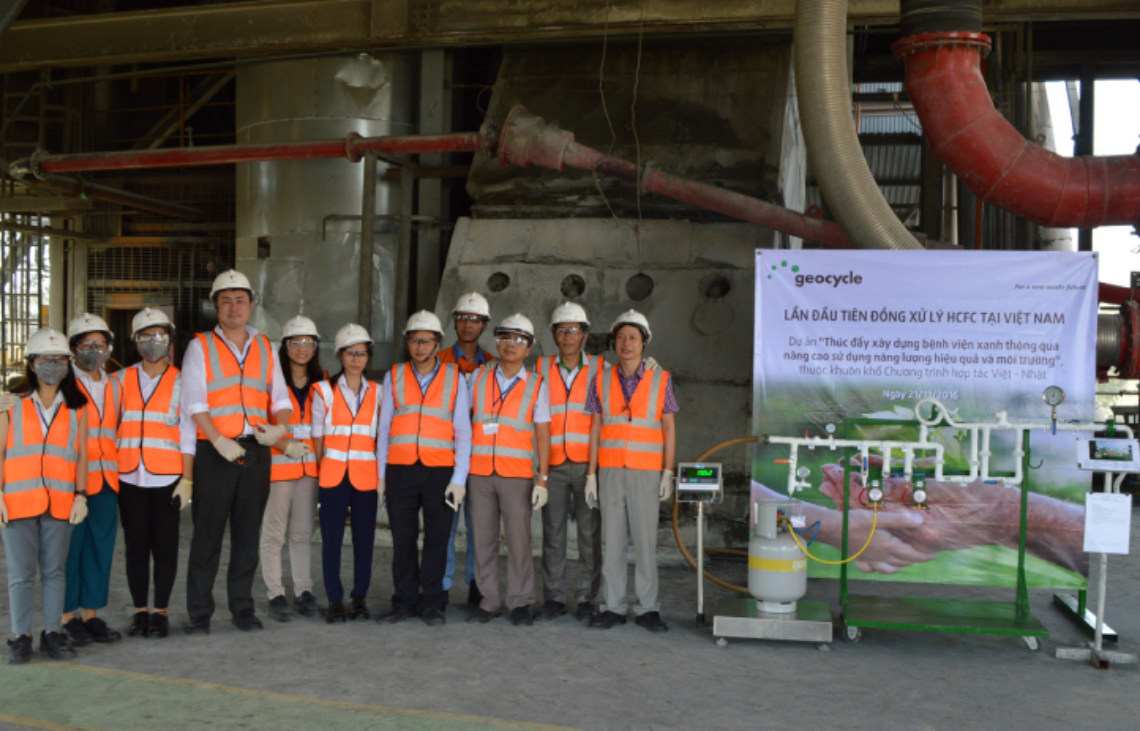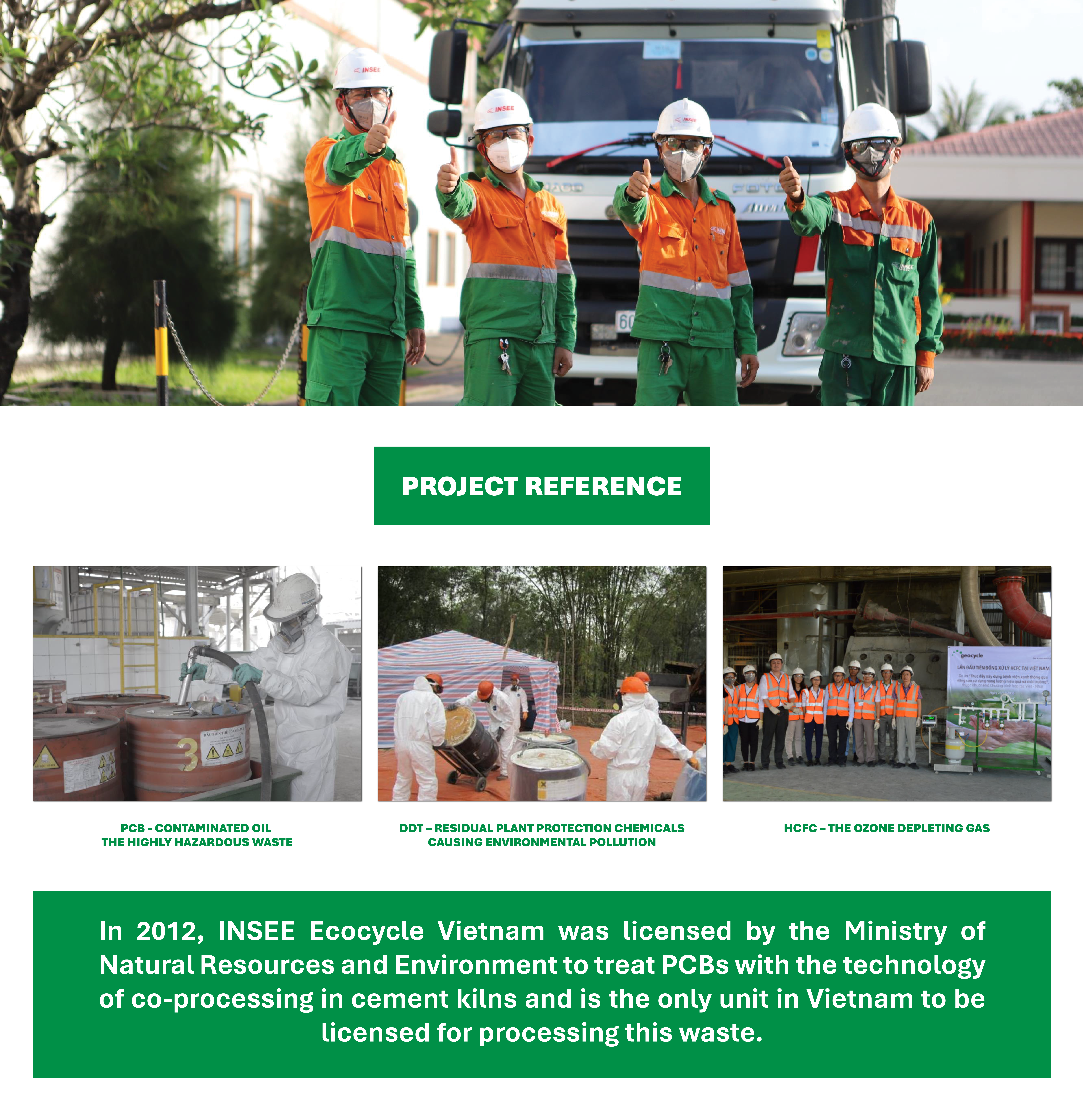PCB-CONTAMINATED OIL – THE HIGHLY HAZARDOUS WASTE
In July, 2018, INSEE Ecocycle successfully treated more than 45 tons of hazardous waste – PCB-contaminated oil, with the technology of co-processing in cement kilns. This is an important activity within the project “PCB Management in Vietnam,” which was approved by the Vietnam Environment Administration (VEA) in order to destroy PCB thoroughly and safely under the Stockholm Convention in Vietnam.
PCB stands for Polychlorinated Biphenyls, one of the 22 POPs in the Stockholm Convention that were forbidden by 2020 and must be safely disposed of by 2028 in Vietnam. PCB has been honored in the past as an ideal additive for insulators in electrical equipment such as transformers and capacitors, until it was discovered to be the cause of numerous environmental disasters in Japan, the USA, etc. The hazardous level of some PCBs is just less than the most hazardous type of dioxin. The International Agency for Research on Cancer (IARC) has classified PCBs into Group 2A, a cagetory of carcinogenic chemicals.
The project “PCB Management in Vietnam” is part of the implementation of the Stockholm Convention in Vietnam by the government of Vietnam and the World Bank, using funding from the Global Environment Facility (GEF). The project contributes to the development of Vietnam’s national capacity to manage PCBs and safely store large amounts of PCBs in the demonstration provinces for future disposal.
The technology of co-processing in cement kilns provides a high temperature environment of up to 2,000°C and a long residence time, enabling the complete removal of complex hydrocarbon compounds without generating secondary waste. Additionally, the emission monitoring system operates continuously during co-processing. Many developed countries in the world have successfully processed PCBs using this technology, such as Norway and Sweden, since the 1980s. INSEE Ecocycle also has experience successfully processing PCBs in Sri Lanka.
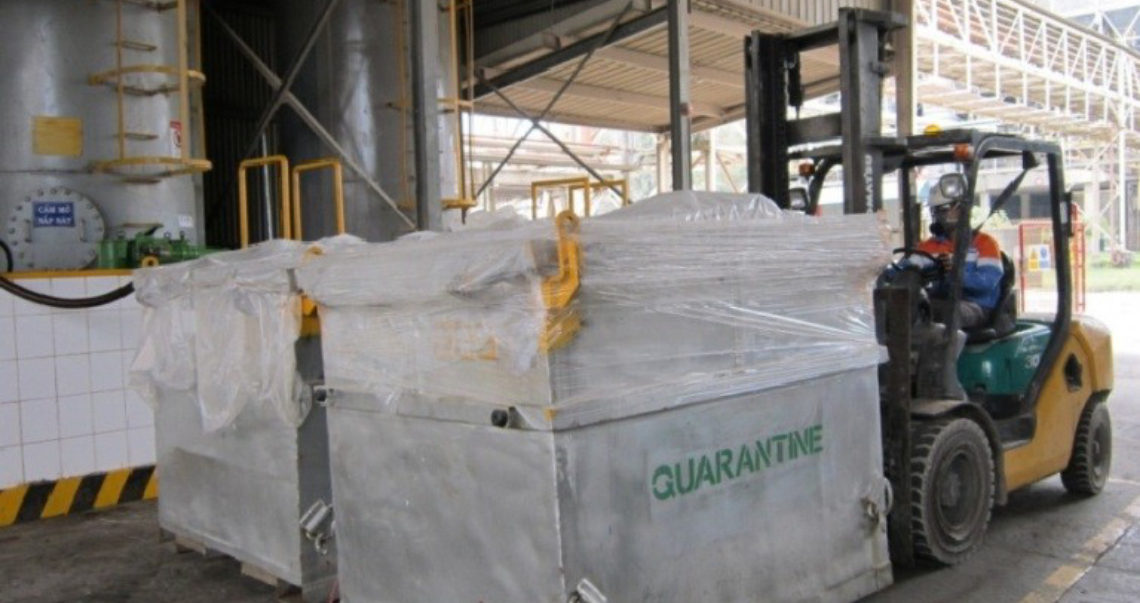
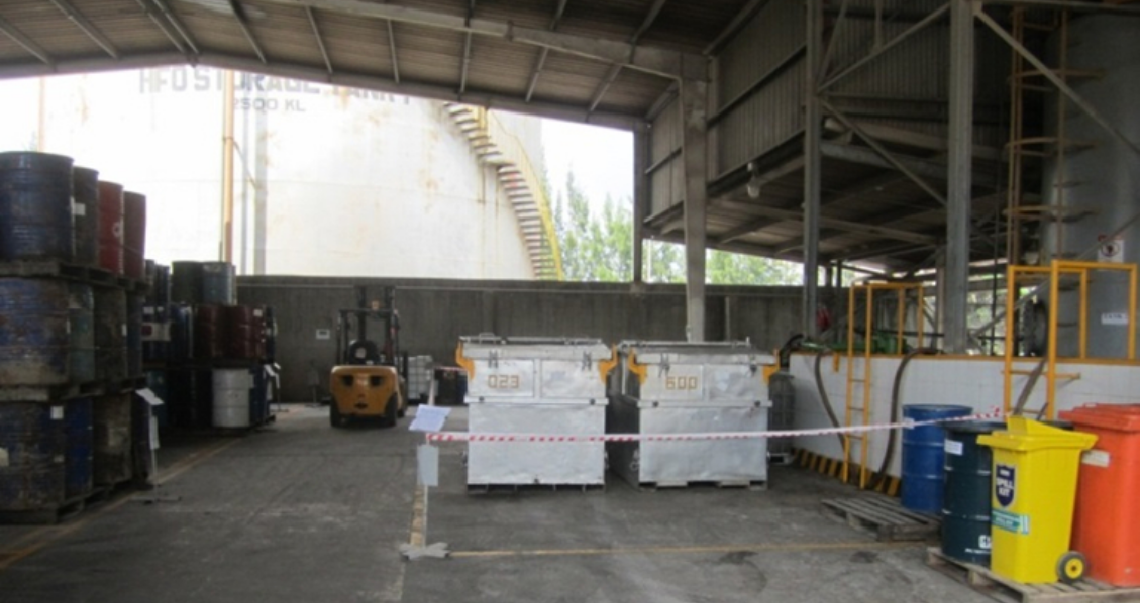
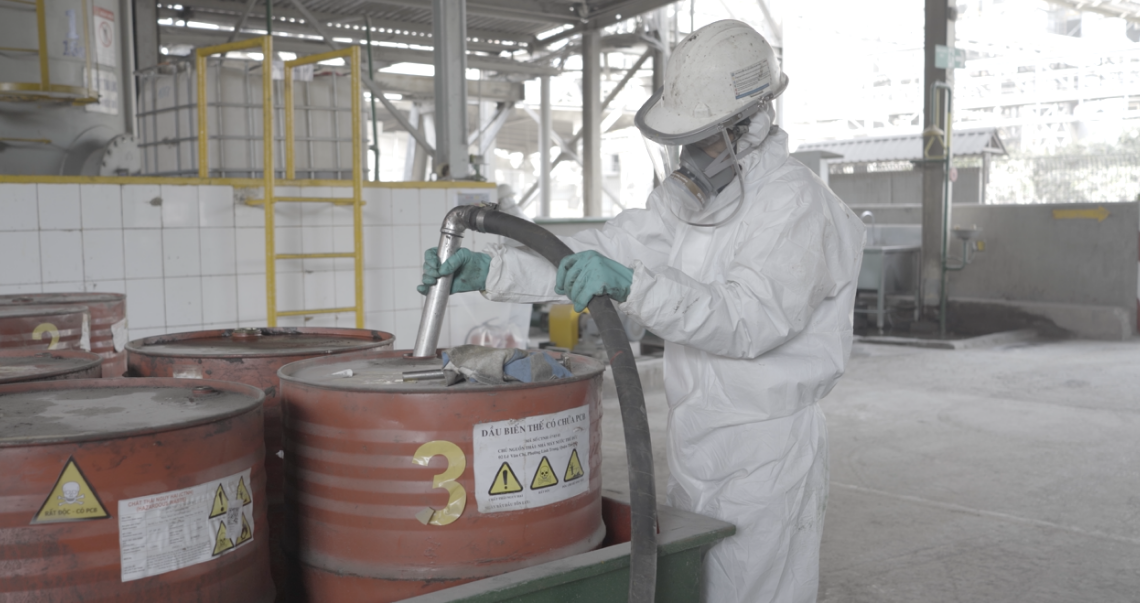
The process of collection and treatment is strictly carried out in accordance with the law and international standards. All steps are researched, evaluated, prepared, and planned carefully, ensuring safety for the environment and for the people who directly implement the work. The Central Control Room will control the gas emissions usinga continuous emission monitoring system that records actual VOC, NH3, O2, HCl, CO, NO, NO2, SO2, and H2O emissions. This process will be monitored by an independent monitoring unit – the Institute of Natural Resources and the Environment. The destruction process will be supervised by the following individuals and organizations: Sai Gon Water Supply Company and the Ministry of Natural Resources and Environment. With this project, INSEE Ecocycle desires to contribute to environmental protection through the thorough and safe treatment of one of the most hazardous wastes identified by the Government of Vietnam and the world. We want to make a positive difference to the environment, improve quality of life, and conserve the natural resources for future generations.
MEDIA INFORMATION ABOUT THIS PROJECT:
-
VTV9 – 24h: https://vtv.vn/video/toan-canh-24h-20-7-2018-312670.htm
-
SCTV8 – News: http://vitv.vn/tin-video/20-07-2018/ban-tin-hop-tin-viet-nam-11h-phat-song-1100-20-07-2018/206804
-
Dan Tri newspaper: http://dantri.com.vn/moi-truong/xu-ly-45-tan-chat-thai-cuc-doc-co-kha-nang-gay-ung-thu-cho-con- nguoi-20180720112842059.htm
-
Newspaper of Natural Resources and Environment: https://baotainguyenmoitruong.vn/moi-truong/dong-xu-ly-loi-thoat-cho-chat-thai-doc-hai-kho-phan-huy-pcb-1256244.html
-
Community Plus Newspaper: http://congdongplus.com/dong-xu-ly-chat-thai-nguy-hai-trong-san-xuat-xi-mang-loi-ra-cho-xu-ly-chat-thai-cuc-doc-tai-viet-nam.html
Reference:
In 2012, INSEE Ecocycle Vietnam was licensed by the Ministry of Natural Resources and Environment to treat PCBs with the technology of co-processing in cement kilns and is the only unit in Vietnam to be licensed for processing this waste. INSEE Ecocycle has proven its ability to handle PCBs thoroughly and fully complies with environmental and safety regulations on gas emissions (National Technical Regulation on Hazardous Waste Co-processing in Cement kilns QCVN 41: 2011 / BTNMT) and related international standards.
In 2014, INSEE Ecocycle Vietnam- the leader in the waste treatment industry, completed the collection of 7 tons of PCB-contaminated oil from Cuu Long Investment Joint Stock Company at Cai Lan port, Quang Ninh. The collection took place under the supervision of many authorities, representatives of Cuu Long Company, and news agencies. INSEE Ecocycle strictly adheres to the national environmental law and applies many professional management systems to ensure that waste management practices are safe for humans and the environment, such as: ISO 9001 & 14001, SEDEX, OHSAS 18000, etc.
DDT – RESIDUAL PLANT PROTECTION CHEMICALS CAUSING ENVIRONMENTAL POLLUTION
According to the Ministry of Waste Management and Environment Promotion, there are about 1153 polluted areas caused by pesticides containing POP. Among these are various types of toxic pesticides that are difficult to destroy. Due to a lack of knowledge, locals stored pesticides in storages facilities that did not meet safety standards. Over time, pesticides have begun to absorb into storage floors and follow underground water, leading to serious pollution in the community.
In light of this severe issue, the Ministry of National Resources and Environment along with the United Nations Development Program issued a bid for a contractor to treat the most contaminated areas of Nghe An and Ha Tinh provinces. It was an international bid, with participants from 14 different local as well as international firms.
On November 30, 2015, INSEE Ecocycle Vietnam processed 870,963 tons of pesticide-contaminated soil stock in 02 provinces, Nghe An and Ha Tinh. This is a part of the “Building Capacity to Eliminate POPs pesticides stockpiles in Vietnam” which was deployed and managed by the Project Management Board POP-Pesticide (Ministry of Natural Resources and Environment) and the UN Development Program in Vietnam.
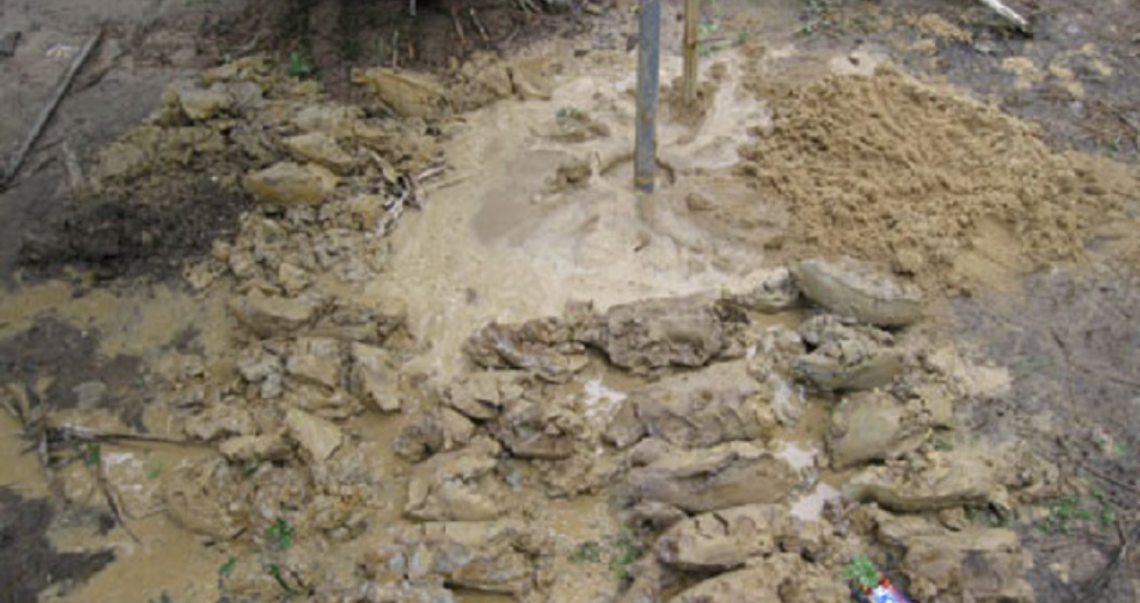
INSEE Ecocycle collected and transported 870,963 tons of pesticide-contaminated soils from the districts of Vuc Rong, Thach Luu, Hon Tro, Chien Thang, Tan Phu, and Nghia Dan to its plant in Hon Chong, Kien Giang province, to be co-processed in cement kilns. The process was supervised by experts from the Ministry of Natural Resources and Environment and the UNDP.
Co-processing in cement kiln technology has been accredited as a safe and environmentally friendly waste management solution thanks to its advantages: Extremely high temperatures – up to 2,000°C, oxygen excess, and long residence time destroy completely waste materials; no residue after the process means no environmental risks compared with incinerators or landfills; high alkaline environment will absorb acid gases generated from the process, thereby eliminating the effects of the acid gas on the environment; and an emission control system 24/24 in every INSEE Ecocycle plants ensures emission safety.
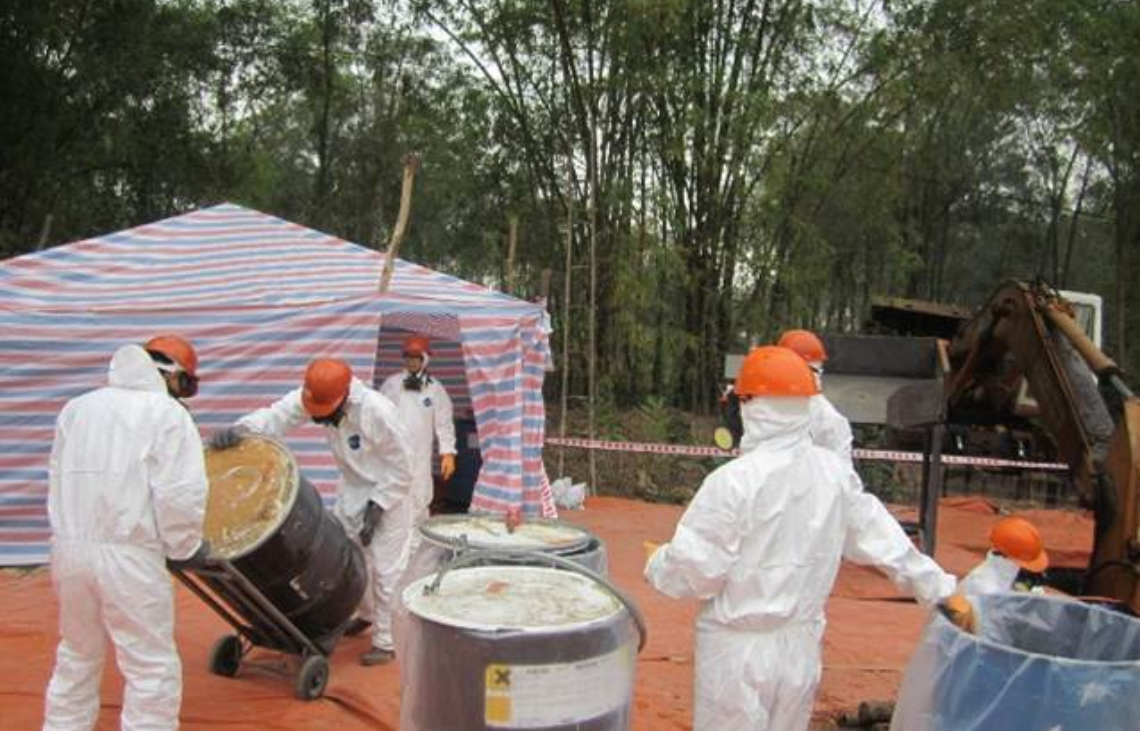
Throughout the process, relevant safety indicators have been strictly monitored and reported. INSEE Ecocycle particularly invited Pacific Environment – an Australian independent third party of environmental impact assessment to measure emissions in the process. The results showed that the treatment did not affect the emission. In fact, all emission indexes were much lower than the limit required, particularly, the concentration of HCl, CO, SO2.
This project against pesticide residue contributes to the goal of “solving all areas of serious environmental pollution and particularly by 2025” as stated by the government of Vietnam. The first ones to experience the difference are the people living in the contaminated area.
HCFC – THE OZONE DEPLETING GAS
What is HCFCs?
HCFC (hydrochlorofluorocarbon) is a chlorine-based refrigerant that depletes ozone– the shield that protects the earth against harmful UV rays from the sun.
HCFC, commonly called R-22 in Vietnam, was used in many older air conditioners.
The treatment of HCFCs reduces the leading cause of ozone depletion, which plays a key role in restoring the ozone layer – the Earth’s shield.
The collection and treatment of HCFCs is part of a project to build a green hospital sponsored by the Mitsubishi Corporation under the framework of cooperation between the two Governments of Vietnam and Japan. It is expected that by 2030, Vietnam will handle 97.5% of the ozone-depleting emissions from air conditioners and old refrigerators.
Under the supervision and support of the Ministry of Natural Resources and Environment, the Ministry of Industry and Trade, the Green Development Center, and Japanese experts, more than 123 kg of HCFCs are put into cement kilns at temperatures above 2,000°C, a long burning time, and a closed feeding system for complete destruction. INSEE Ecocycle Vietnam is proud to be the pioneer in processing HCFCs using co-processing technology.
This HCFC is collected from the air-conditioners of the two hospitals, Viet Duc Friendship Hospital and the People’s Hospital 115, as part of the project “Building the green hospitals through the improvement of effective & environmentally friendly energy use in Vietnam” under the cooperation between the Governments of Vietnam and Japan.
Nearly 20 prestigious press agencies across the country simultaneously reported on the event, such as:
Vietnam Television (VTV): http://vtv.vn/chuyen-dong-24h/lan-dau-tien-viet-nam-xu-ly-duoc-chat-lam-thung-tang-ozon- 20161121184350916.htm
Business Integration Magazine: http://doanhnghiephoinhap.vn/holcim-viet-nam-dong-xu-ly-thanh-cong-chat-thai-hcfc.html
Ministry of Industry and Trade News: http://www.moit.gov.vn/en/pages/Tinchuyende.aspx?Machuyende=TLCV&IDNews=8485
HCFC TREATMENT PROCESS IN INSEE ECOCYCLE VIETNAM
INSEE Ecocycle Vietnam has detailed plans for all steps, from analysis, testing, and transportation to co-processing in cement kilns. Waste-handling experts are trained and equipped with the necessary protection to ensure that all operations with waste are safe. Risk assessments are communicated to workers and staff in a clear and timely manner. Prevention and controlling measures for fire, ,and explosion are always available.
Collection and transportation
The HCFC tanks were visually risk-assessed, wrapped in foam to avoid collisions, and contained in secondary containers secured by the straps. In addition, the GPS system monitors the shipment from pick-up to the transportation stage to the factory.
TREATING HCFC THOROUGHLY & SAFELY USING THE ‘CO-PROCESSING IN CEMENT KILNS’ SYSTEM
Cement kilns with high thermal capacity of up to 2,000°C, a long residence time, a high oxidation environment, together with a closed feeding system, are monitored continuously for the complete destruction of HCFC compounds. Co-processing is recognized as a feasible, efficient, and environmentally friendly solution for the general disposal of waste in the world and is supported by international organizations such as the World Health Organization (WHO), the Business Council, the World of Sustainable Development, the Basel Convention, and the European Cement Association.
The exhaust gas is regulated by a 24/7 continuous emission control system to ensure that the overall waste disposal, especially HCFC, does not cause any environmental impact and complies with requirements according to environmental legislation in Vietnam & the highest standards of the corporation. It can be said that the event of successfully co-processing HCFCs is a big turning point in protecting the ozone layer in Vietnam, contributing to raising public awareness , especially among enterprises, to jointly fight against climate change.
